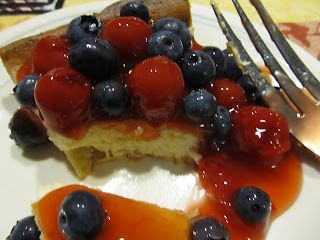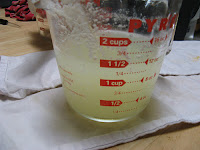 I found it at allrecipes.com: Italian Cream Cheese and Ricotta Cheesecake. Because my husband has to eat gluten free, I adjusted it a bit. I had some thick, firm homemade sour cream that I used instead of the required cream cheese and also substituted the sour cream at the end of the recipe with strained yogurt. I also made a smaller recipe for a pie plate instead of a spring form pan. (I rarely make a recipe exactly as it appears. If you want to see the original version, check out the link.)
I found it at allrecipes.com: Italian Cream Cheese and Ricotta Cheesecake. Because my husband has to eat gluten free, I adjusted it a bit. I had some thick, firm homemade sour cream that I used instead of the required cream cheese and also substituted the sour cream at the end of the recipe with strained yogurt. I also made a smaller recipe for a pie plate instead of a spring form pan. (I rarely make a recipe exactly as it appears. If you want to see the original version, check out the link.)Italian Ricotta Cheesecake -- Gluten free
Ingredients
8 oz. cream cheese
8 oz. homemade ricotta cheese (or store-bought)
3/4 c. white sugar
2 eggs
1 1/2 t. lemon juice
1/2 t. vanilla
2 T. cornstarch
1 T. gluten-free flour (I use Bob's Red Mill all-purpose flour substitute.)
1/8 t. xanthan gum
1 c. sour cream
1/4 c. butter, melted and cooled (which I forgot to add)
Directions
1. Preheat oven to 350 degrees. Lightly grease a 9 inch pie plate.
2. Mix the cream cheese and ricotta cheese together in a mixing bowl until well combined. Stir in the sugar, eggs, lemon juice, vanilla, cornstarch, flour, and butter. Add the sour cream last.
3. Pour the mixture into the prepared pan.
4. Bake in the preheated oven 1 hour; turn the oven off and leave in the oven 1 hour longer. Allow to cool completely in refrigerator before serving. Serve with your favorite fruit toppings.
If you go to the allrecipes link, you can read other comments by other cooks. This turned out to be a deliciously light dessert. Though I love graham cracker crusts, this is a good crustless version. We served it with cherries and blueberries.
Try it, you'll like it!













